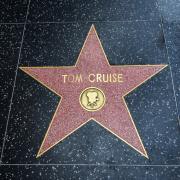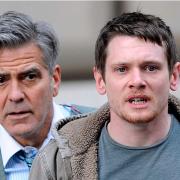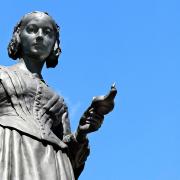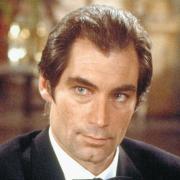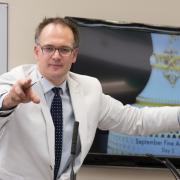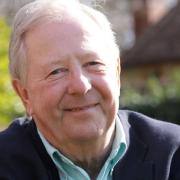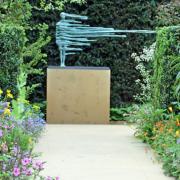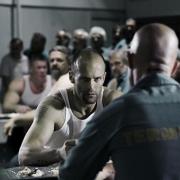Mike Smith meets award winning producer and film-maker Graham Hoyland, the man intent on solving the mystery surrounding the first accent of Everest.
The first conquest of Everest did not take place in the coronation year of 1953, but 29 years earlier, on 8th June 1924, when George Mallory and Andrew Irvine made a successful ascent of the world’s highest mountain, before they fell and died on its icy slopes. This is the conclusion reached by Graham Hoyland, an award-winning BBC producer, director and film-maker, who has been on eight Everest expeditions and became the fifteenth Briton to stand on top of the world when he climbed to the summit in 1993.
Although Graham is able to back up his assertion with lots of compelling arguments, he knows that the history books will only be re-written when he produces conclusive evidence that Mallory and Irvine actually stood on the summit. Ever since a life-changing meeting that took place when he was just twelve years old, he has known exactly what form that evidence would take and he has spent much of the last four decades searching for it.
When I met Graham at his cottage in The Wash, a secluded hamlet in the heart of the High Peak, he told me about the meeting that prompted his life-time obsession. He was attending the funeral of Dorothy Cadbury, a member of the family of chocolate-makers, when he fell into conversation with his great uncle, Howard Somervell, affectionately known as Uncle Hunch. Somervell was a remarkable man, who was an accomplished painter, a transcriber of Tibetan music, a surgeon who spent many years working at a mission hospital in India, where he became one of the world’s leading authorities on duodenal ulcers, a respected mountaineer and the president of the Alpine Club from 1962 to 1965. Even more crucially, he was a friend of George Mallory and a member of the 1924 Everest expedition.
Recalling his conversation with Somervell, Graham said: ‘Uncle Hunch told me that two unsuccessful attempts on the summit were made during the 1924 expedition. The first was made by George Mallory and Charles Bruce, and the second by my uncle and Edward Norton. On his way down from the summit bid, Uncle Hunch suffered a blockage in his throat. Knowing that he was severely ill, he sent Norton on to the camp and sat down to wait for what he thought would be his certain death. However, in a desperate last attempt to clear his throat, he compressed his lungs by putting his arms across his chest and somehow managed to dislodge the blockage.
Continuing his descent, my uncle encountered Irvine and Mallory, who were making their attempt on the summit. On discovering that Mallory, who was notoriously absent-minded, had forgotten to take a camera, Uncle Hunch gave the two climbers his own camera. If the pair did reach the summit, as my uncle believed they did, their feat would have been recorded on the film of that camera, which, unfortunately, has never been found. When Uncle Hunch told me this story, I resolved there and then that I would try to locate the camera and have the film processed, so that I could prove, once and for all, that Mallory and Irvine were the first climbers to reach the summit of Everest. I’ve spent much of the last 40 years searching for it.’
When I asked Graham why he is so convinced that Mallory and Irvine reached their ultimate goal, even though he does not have the photographic evidence to prove it, he pointed out that Mallory was highly motivated to conquer the mountain in 1924, particularly as he had failed to reach the summit on two previous expeditions. His determination was reflected in his willingness to carry oxygen on this occasion, even though he had previously rejected its use as ‘unsporting’. It was in the nature of the man, and in line with the spirit of the age, for him to go for the top, despite the risk to his life. What’s more, the weather was good at the time of the climb and the two men were seen heading strongly up thesummit ridge by Noel Odell, the geologist on the expedition.
When Odell was asked to recall his last sighting of the climbers, he said: ‘There was a sudden clearing of the atmosphere and the entire summit ridge and the final peak of Everest were unveiled. My eyes became fixed on one tiny black spot silhouetted on a small snow-crest beneath a rock-step on the ridge; the black spot moved. Another black spot became apparent and moved up the snow to join the other on the crest. The first then approached the great rock-step and shortly emerged at the top; the second did likewise. Then the whole fascinating vision vanished, enveloped in cloud once more.’
If Odell really did see the two men reach the top of the so-called ‘Second Step’, which is by far the most difficult part of the final climb, it is almost certain that they would have gone on to the summit. However, doubt has been cast on Odell’s recollection of what he saw. Some believe that he actually spotted the climbers on the easier First Step, while others maintain that the Second Step would have proved far too difficult, even for Mallory, who was regarded as the best rock-climber of his generation.
Graham has his own theory. Arguing that Odell could not have seen the men on either the First Step or the Second Step from where he was standing, he believes that he actually saw them ascending the final and relatively easy Third Step. Accepting that the Second Step would have presented insurmountable difficulties to the two climbers, he contends that Mallory and Irvine simply by-passed that step altogether by traversing underneath it to the Third Step.
Knowing that only the processing of Uncle Hunch’s film could prove that Mallory and Irvine made it to the top, Graham joined a 1999 expedition that set out to look for Somervell’s camera and for the bodies of the two climbers. In fact, it was Mallory’s body that was found during the search. A thick hemp rope was tied around the dead man’s waist and its ends were frayed, indicating where it had broken during his fall. Among the climber’s belongings were a pair of nail scissors and a wrist watch, minus its hands, but there was no camera. This did not surprise Graham, because he contends that Irvine, as a more junior member of the expedition, would have carried the camera in order to record Mallory’s triumph.
Irvine’s ice axe was found on Everest in 1933 and a Chinese climber called Wang Hongbao claimed in 1975 that he had seen an ‘English dead’ some 750 feet below the axe. This could well have been Irvine, but it was difficult to ascertain the exact location of the body, because Wang could not be questioned as he was tragically killed the following day in an avalanche. Graham has made numerous television programmes about his own attempts to find the climbers and their camera. In 2006, he went to Everest wearing exact replicas of the type of clothes worn by Mallory and Irvine and found that they were sufficiently warm to withstand extreme conditions during daylight, but inadequate for an overnight bivouac, which could help to explain the climbers’ deaths in the late evening.
Graham has not given up hope of finding Irvine, particularly as he believes that it will have become easier to spot the camera, which may have become exposed by melting snow in these days of global warming. He plans to return to the mountain in 2011 to make what will probably be his last attempt to find Irvine and the camera.
In the meantime, this indefatigable adventurer has bought a 42-ft steel sailing boat that will withstand bruising encounters with coral and ice. Named Curlew, after a bird that is equally at home above land and sea, it has been purchased to allow Graham to take on the self-imposed challenge of becoming the first person to sail all seven seas and climb the highest peaks on all seven continents within the space of two years. If he pulls off this feat, he will have his own place in the history books, even if he fails to prove that Mallory and Irvine should be given their rightful place in the history of Everest.



